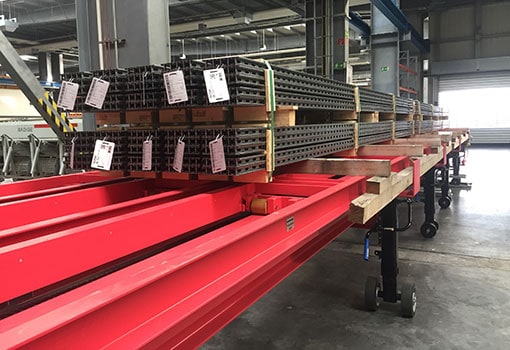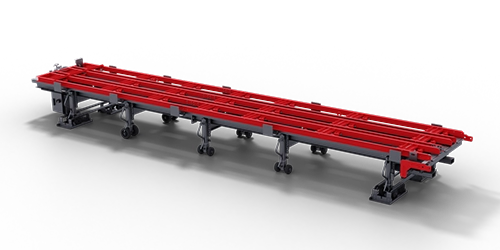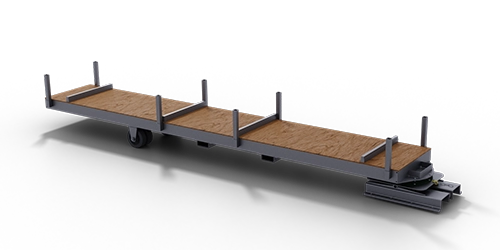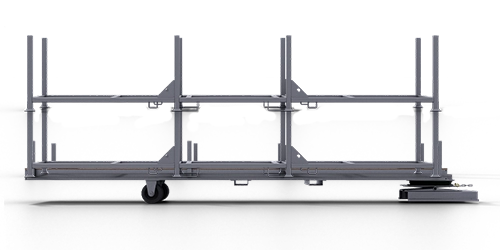A toolbox is the easiest way to handle material. A box that provides the necessary flexibility and variability will make the tools easier to transport and faster to access. If, however, they are not properly cleared away after use, their benefit is reduced.
This already demonstrates the advantages of a system that must, admittedly, be handled correctly. But material handling systems are much more than just upscaled toolboxes. When used correctly, these systems can make company processes easier and safer, and increase productivity. They save on storage space or can be used directly as buffer storage facilities. Given the combination of practical and financial benefit, you would think material handling systems – and the targeted use thereof – would be highly prevalent. But the reality is that people tend to transport their materials using vehicles configured to personalised needs, homemade or purchased solutions which, while not 100% suitable, are made as suitable as possible. In other words, compromises are made.
This is primarily due to the fact that acute demand often takes greater priority over structuring all components systematically. And of course users focus on specific tasks, which in turn results in stand-alone solutions.
The general requirements for material-handling systems are not too shabby: Reliability and load-bearing capacity. Mobility and flexibility. Plus great value for money.
Incorporating the systems approach in view of this is very challenging. But it is possible.
The answer to all of the above can be summarised in one word: SIMPLY.
SIMPLY. Material Handling System: More than a material carrier
A provider of material-handling systems that offer even more. They’re more than material carriers, improvisations or stand-alone solutions that can no longer even be used in the neighbouring workshop.
The idea behind the SIMPLY. material-handling systems is not to offer patent formulae, but rather always a basis. These can then be individually expanded, but still remain within a systematic framework. What this looks like is in turn measured on a series of parameters. For example, a system should also always be a process component. That means not buying a finished product or something off the shelf – but rather first determining what the product must be able to offer, which work stage it is used in, and where. All in combination with other system components. A principle that’s easy to understand. No one goes into a shop just to buying “something to wear”; they have something specific in mind, such as a robust casual jacket to match their favourite pullover and jeans. And the next aspect it just as logical: Following standards.
SIMPLY. Material Handling System: For Euro-pallet Conveyor
A Euro-pallet conveyor is just one example. Clearly. In this case, SIMPLY. is geared around the dimensions for the pallets or pallet cages. But standards also mean offering a drawbar with fork sockets for all conventional industrial trucks.
And which can thus transform into a locomotive set at the railyard in the blink of an eye. Optimum usage of space is of course also standard. If, in the case of a Euro-pallet conveyor, the clearance width is equal to the usable width, the “standard” system helps create useful space. SIMPLY. similarly places great emphasis on compatibility. Industrial platform conveyors don’t just transport sheet-metal, plastic, lasered or welded parts; they also transport the SIMPLY. warehouse-pallet system.
This also reflects other aspects of a functioning system: Practicality and logical handling.
SIMPLY. Material Handling System: For Industrial Pallet Conveyor
An industrial pallet, for example, will be virtually useless if it can’t be moved where it needs to go. And even more so if it can’t withstand anything. This is when we see the importance of the fact that SIMPLY. did not start out as a manufacturer of material-handling systems. The company was originally designed to build flood-protection systems. All system components were thus developed based on practical requirements, with the option of scaling them for other tasks at any time.
Regardless of the purpose, this initially means building something that’s robust and durable. Which is why the industrial platform conveyors, industrial pallets and Euro-pallet conveyors are made from solid steel and are hot-dip galvanised. This makes them resistant to even rough handling, enables them to bear heavy loads, and of course be weatherproof. And unlike aluminium designs, contact corrosion is not an issue either. You get variability instead. As such, Euro-pallet conveyors can also be equipped with a pallet-stacking system. It can be stored wherever there is space; if necessary even in a sheltered corner of the yard, serving as a collective storage facility as part of the deposit return system. If the conveyor is full, it can be transported along by any industrial truck. Its drawbar has a fork socket, and is fully swivel-mounted, making it extremely agile. It is intended less for yards and more as a way of handling the cramped conditions of a workshop or warehouse. After all, the vehicle can also accommodate pallet cages, and thus also serve as a buffer storage facility – particularly as it is no wider than the pallet cage itself, and several of them can thus be placed next to one another to save space.
The same applies to industrial platform conveyors individually equipped with non-slip mats or warehouse-pallet systems. When combined with industrial pallets, this automatically results in a wide range of options for work preparation.






